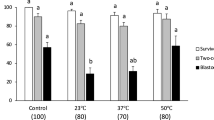Abstract
During a cryopreservation process a preimplantation embryn has to undergo multiple changes in volume caused by osmotic forces. When parameters such as cryoprotectant and water permeability coefficients and their temperature coefficients are known, equations can be solved to predict the volume response of an embryo during cryopreservation. This approach will allow the development or madification of cryopreservation procedures using relatively few embryos.
Similar content being viewed by others
References
Mazur P, Schneider U: Osmotic responses of preimplantation mouse and bovine embryos and their cryobiological implications (submitted for publication)
Mazur P, Rall WF, Leibo SP: Kinetics of water loss and the likelihood of intracellular freezing in mouse ova. Cell Biophys 1984;6:197–213
Schneider U, Mazur P: Osmotic consequences of cryoprotectant permeability and its relation to the survival of frozenthawed embryos. Theriogenology 1984;21:68–79
Jackowski S, Leibo SP, Mazur P: Glycerol permeabilities of fertilized and unfertilized mouse ova. J Exp Zool 1980; 212:329–341
Mazur P, Leibo SP, Miller RH: Permeability of the bovine red cell to glycerol in hyperosmotic solutions at various temperatures. J Membr Biol 1974;15:107–136
Mazur P, Miller RH: Permeability of the human erythrocyte to glycerol in 1 and 2M solutions at 0° or 20°C. Cryobiology 1976;13:507–522
Mazur P, Rigopoulos N, Jackowski SC, Leibo SP: Preliminary estimates of the permeability of mouse ova and early embryos to glycerol. Biophys J 1976;16:232a
Rall WF, Mazur P, McGrath JJ: Depression of the ice-nucleation temperature of rapidly cooled mouse embryos by glycerol and dimethyl sulfoxide. Biophys J 1983;41:1–12
Miyamoto H, Ishibashi T: Effects of the temperature of iceseeding on survival of frozen and thawed mouse morulae. Experientia 1981;37:187–188
Leibo SP, Mazur P: Methods for the preservation of mammalian embryos by freezing:In Methods in Mammalian Reproduction, JC Daniel Jr (ed). New York, Academic Press, 1978, pp 179–201
Leibo SP, McGrath JJ, Cravalho EG: Microscopic observation of intracellular ice formation in unfertilized mouse ova as a function of cooling rate. Cryobiology 1978;15:257–271
Takeda T, Elsden RP, Seidel GE Jr: Cryopreservation of mouse embryos by direct plunging into liquid nitrogen. Theriogenology 1984;21:266
Leibo SP: Water permeability and its activation energy of fertilized and unfertilized mouse ova. J Membr Biol 1980;53:179–188
Willadsen SM: Factors affecting the survival of sheep embryos during deep-freezing and thawing.In The Freezing of Mammalian Embryos, Ciba Foundation Symposion 52. Amsterdam, Elsevier, Excerpta Medica, 1977, pp 175–202
Rall WF, Reid DS, Farrant J: Innocuous biological freezing during warming. Nature 1980;286:511–514
Senger PL: Handling frozen bovine semen—factors which influence viability and fertility. Theriogenology 1980;13:51–62
Mazur P: Freezing of living cells: Mechanisms and implications. Am J Physiol (Cell Physiol 16) 1984;247:C125-C142
Mazur P, Rall WF, Rigopoulos N: Relative contributions of the fraction of unfrozen water and of salt concentration to the survival of slowly frozen human erythrocytes. Biophys J 1981;36:653–675
Schneder U, Mazur P, Cole K: Does the magnitude of the unfrozen fraction affect the survival of slowly frozen mouse eight-cell embryos? Cryobiology 1984;21:710
Glenister PH, Whittingham DG, Lyon MF: Further studies on the effect of radiation during storage of frozen 8-cell mouse embryos at −196°C. J Reprod Fert 1984;70:229–234
Schneider U, Maurer RR: Factors affecting survival of frozen-thawed mouse embryos. Biol Reprod 1983;29:121–128
Lehn-Jensen H, Rall WF: Cryomicroscopic observations of cattle embryos during freezing and thawing. Theriogenology 1983;19:263–277
Willadsen S, Polge C, Rowson LEA: The viability of deepfrozen cow embryos. J Reprod Fert 1978;52:391–393
Rall WF, Wood MJ, Kirby C: The transfer of frozen-thawed mouse embryos in dimethyl sulfoxide: Effect of dilution and short-term culture. Cryobiology 1984;21:710–711
Leibo SP: A one-step method for direct nonsurgical transfer of frozen-thawed bovine embryos. Theriogenology 1984;21:767–790
Author information
Authors and Affiliations
Rights and permissions
About this article
Cite this article
Schneider, U. Cryobiological principles of embryo freezing. J Assist Reprod Genet 3, 3–9 (1986). https://doi.org/10.1007/BF01131373
Issue Date:
DOI: https://doi.org/10.1007/BF01131373




